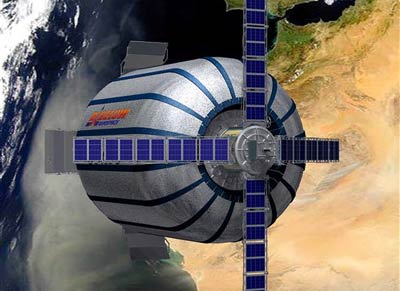Genesis and the future space hotelby Taylor Dinerman
|
| Actually having an experimental module on orbit is essential in order to show investors that this industry is going to be in business for a long time to come. |
Only a few space tourists will be content with a short ride into orbit followed by a uncomfortable stay inside a cramped spaceplane or capsule. They will want at least a semblance of the kinds of comforts available on the cheapest package vacation. Therefore the “space hotel” is the minimum system needed to give the industry a chance to grow beyond just a limited number of hardy adventurers. A space hotel will be the one place where tourists will be able to relax and enjoy themselves without suffering from the embarrassments and claustrophobia that are inevitable when someone with minimal training flies into orbit in a capsule or small vehicle.
So far space tourists like Dennis Tito and his successors have gone through long months of cosmonaut training in Russia. They have been physically and mentally prepared for their trips. If the industry is to reach a broader public, passengers will have to be able to go up with, at most, only a few weeks training and preparation. This means that a space hotel will have to be extremely user friendly.
It will also have to provide generous facilities for viewing the Earth. Aside from the thrill of just being there, the main attraction for most people will be looking down at the fantastic spectacle of our ever-changing planet. This means that any space hotel will have to have a number of fairly large windows. Yet, as spacecraft designers have discovered, windows are a vulnerable point. Last year, for example, there was a problem with one of the windows on the International Space Station.
In order to make sure that their future space hotels’ windows will not be a constant source of problems, Bigelow Aerospace decided that they would incorporate windows into their test module right from the start. Even though the thickness of the module’s skin is less than half of the skin of a full scale space hotel, putting a window into it is a good way of gaining experience and insuring that the design, especially the seals, are genuinely spaceworthy. The Genesis designers installed a camera on the inside that does nothing but monitor the window.
Instruments on board include dosimeters, microphones, and interior cameras that will, on future missions, record the weightless antics of items that the public will be send up via Bigelow’s “Fly Your Stuff” program. It will be interesting to see if this catches on; in any case, it’s an indication that the company is looking to generate some cash flow even before it has its first paying hotel guest.
| Tourists will want at least a semblance of the kinds of comforts available on the cheapest package vacation. Therefore the “space hotel” is the minimum system needed to give the industry a chance to grow beyond just a limited number of hardy adventurers. |
They plan to launch their next experimental module late this year, and will probably be launching them at a rate of at least two a year for the next four or five years. Once Elon Musk’s SpaceX has its Falcon launch vehicle in operation they hope to use that, as well as the Dnepr, to send ever more sophisticated and reliable systems into obit until sometime in the middle of the next decade they will be able to begin work on a habitable structure that can actually be called a real space hotel.
As others have pointed out, these modules have great potential for purposes other than just as parts of the space hotel. They could be used to as part of a permanent base on the Moon, they could be useful as part of a large fuel depot in Earth orbit, they could even become part of the International Space Station if it was ever thought necessary to expand it beyond the currently-planned configuration.
Bigelow Aerospace has taken a big chance with this technology, and so far the development and design phase has gone well. They are now into the prototype testing phase. They are off to a good start, but as with any new system, there will be problems and failures. The real challenge for the company and its leadership will be to see how well it handles the inevitable setbacks.
